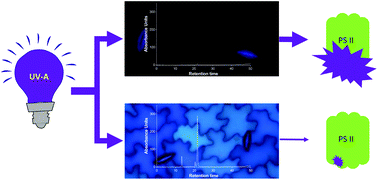Hydroxycinnamic acids in sunflower leaves serve as UV-A screening pigments†
Abstract
Flavonoids and hydroxycinnamic acid derivatives, which are located in the upper epidermis of plants, are well known to screen ultraviolet radiation, thus protecting the underlying tissue from these harmful wavelengths. Both classes of secondary products complement each other over the UV spectral region according to their absorption spectra: flavonoids are most efficient as UV-A attenuators while hydroxycinnamates (HCAs) screen well within the UV-B region. Analysis of epidermal transmittance revealed a substantial UV-A screen in Helianthus annuus L. cv. Peredovick. Identifying responsible pigments by HPLC-MS, we found surprisingly low amounts of flavonoids but dominant abundance of the HCA derivatives chlorogenic and di-caffeoyl quinic acid. Both display low UV-A absorbance and thus, should contribute only a little to UV-A protection. However, growth at high light led to a decrease of epidermal transmittance at 366 nm of up to 90%. Underpinning the screening role, HCA autofluorescence microscopy revealed storage to occur predominantly in vacuoles of the upper epidermis. UV-A treatment in the absence of D1-repair resulted in photosystem II inactivation proportional to epidermal UV-A transmittance. Our findings suggest that UV-A protection can be achieved solely with HCAs, apparently through accumulation of high amounts of these compounds.

- This article is part of the themed collection: Plant responses to UV


 Please wait while we load your content...
Please wait while we load your content...